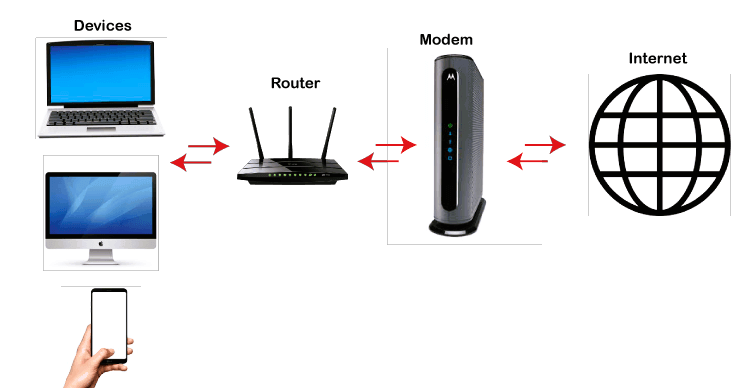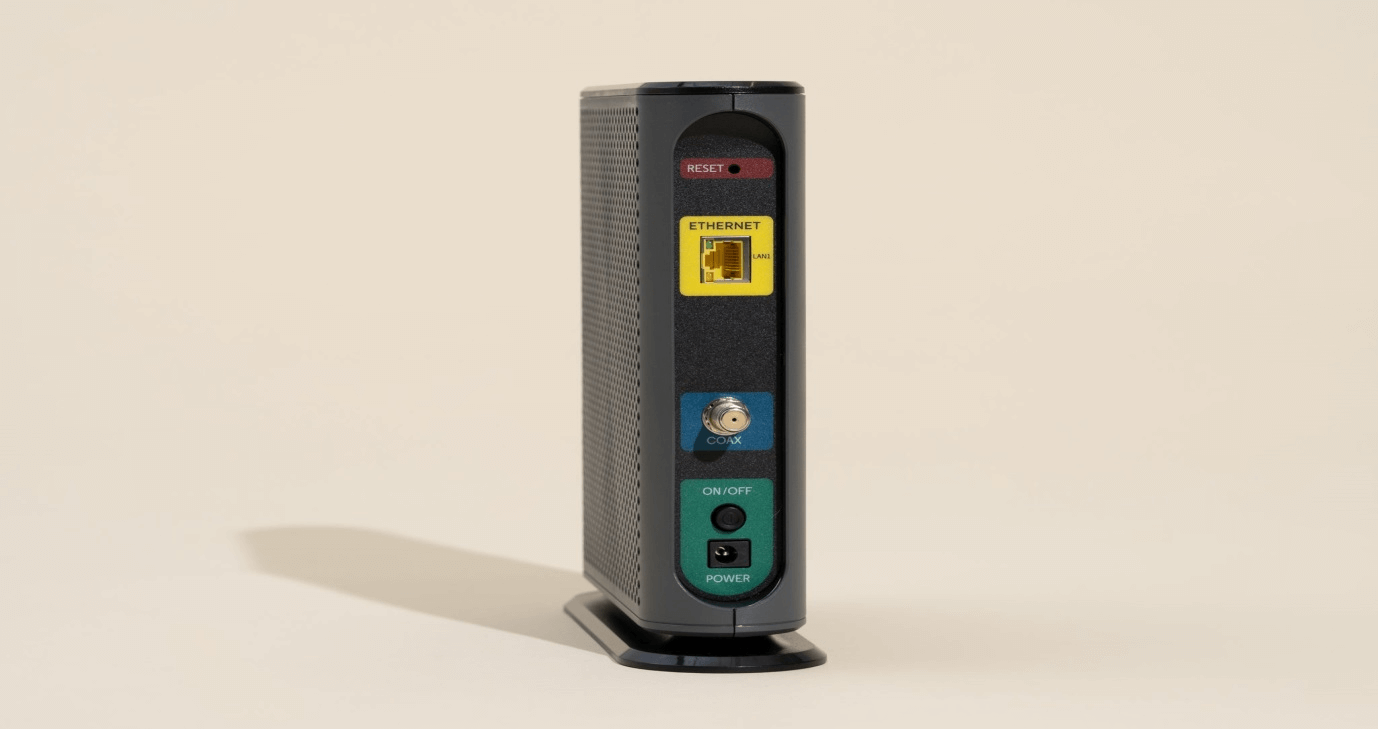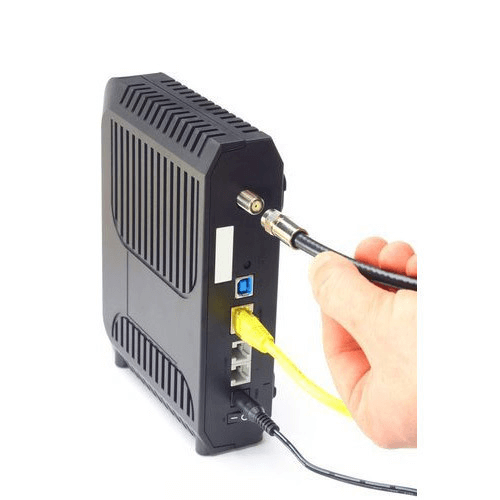Modem DefinitionIntroductionAn electrical device that transforms digital data signals into modulated analog signals suitable for transmission over analog telecommunications circuits is called a modem (from "modulator/demodulator"). A modem also receives and decodes modulated signals to recover the digital signal for use by the data device. Thus, modems allow data communication to be supported by the current telecommunications infrastructure, such as e-mail across personal computers, fax transmission among fax machines, and downloading audio-video files from a World Wide Web server to a personal computer at home. 
Most modems are "voiceband" devices, allowing digital terminal equipment to communicate across telephone lines created to accommodate the limited bandwidth needs of the human voice. On the other hand, cable modems enable data transfer across hybrid fiber-coaxial lines initially intended to provide high-bandwidth television service. Both voiceband and cable modems are advertised as standalone, book-sized modules that connect to a telephone or cable outlet and a port on a personal computer. Additionally, voiceband modems are built inside fax machines and PCs as circuit boards. They may also be purchased as tiny laptop-plug-compatible card-sized devices. Parameters of operationModems must adhere to compatible operational standards or protocols to communicate with one another. The V-series of recommendations released by the International Telecommunication Union (ITU)'s Telecommunication Standardisation sector serve as the global benchmarks for voiceband modems. These standards define comparable modulation and encoding systems, ensure similar transmission rates, and specify the signaling process through which modems begin and end connection, among others. To handle slower modems, modems might "fall back" to lower speeds. Standards that provide "full-duplex" transmission and reception enable interactive communication. "Half-duplex" standards also enable two-way communication, but not simultaneously; these modems are suitable for facsimile transmission. Binary digits, or bits 0 and 1, representing two values, are repeatedly alternated to form data signals. Comparable to the tones of the human voice, analog signals are made up of time-varying, wave-like changes in value. Modems use several techniques to do this; they are listed in the section below on developing voiceband modems. A baud is a unit of measurement for each altered component of the modulated carrier wave (such as a frequency or phase shift). A modem running at 300 bauds per second (or, more simply, 300 baud) transferred data at 300 bits per second because, in early voiceband modems, dating from the early 1960s, one baud equaled one bit. Since a baud in current modems may represent several bits, bits or kilobits (thousand bits per second) are a more precise way to evaluate transmission rate. The throughput of modems has increased throughout their development from 300 bits per second (bps) to 56 kilobits per second (Kbps) and beyond. A few megabits per second (Mbps; million bits per second) is the throughput of cable modems. Channel-encoding techniques must be used at the highest bit rates to minimize transmission mistakes. Different source-encoding techniques may "compress" the data into fewer bits, boosting the information transmission pace without increasing the bit rate. Development of voiceband modemsThe first generationWhile early research on telephotography machines?the predecessors of current fax machines?conducted by the Bell System in the 1930s did not directly relate to digital data transfer, it did result in strategies for overcoming certain signal flaws present in telephone circuits. These advancements included techniques for equalizing fax signals to prevent smearing and converting fax signals into 1,800-hertz carrier signals that could be delivered over the phone. The requirement to transmit data for North American air defense during the 1950s inspired the initial digital modem development attempts. By the end of that decade, 750 bits per second of data were being sent over traditional telephone connections. The American Telephone & Telegraph Company (AT&T) released the Bell 103 modem in 1962 as the first modem to be made commercially accessible in the United States. Full-duplex data transfer at up to 300 bits per second over traditional telephone connections was made possible with the Bell 103. Two frequencies (one pair for each direction) were used to transmit and receive binary data over the telephone circuit. A change to one pair frequency signaled a binary 1, while a shift to the other pair frequency signaled a binary 0. Frequency-shift keying, or FSK, is the name of this kind of digital modulation. A short while after the Bell 103, the Bell 212 modem was released. The Bell 212 used phase-shift keying, or PSK, to modulate a 1,800-hertz carrier signal and sent data at a rate of 1,200 bits, or 1.2 kilobits, per second over full-duplex telephone connections. Phase shifts of a single carrier signal serve as the basis for PSK data representation. Consequently, a binary one can be conveyed as a 180-degree phase shift, but a binary 0 could be sent as a zero-degree phase shift. Significant work was devoted to creating modems with even greater transmission speeds between 1965 and 1980. These initiatives aimed to remove the many phone line flaws directly inhibiting data transfer. Robert Lucky of Bell Laboratories created an automatic adaptive equalizer in 1965 to account for data symbols mixing due to faulty telephone circuit transmission. Although equalization was a well-known principle used for many years in telephone lines and cables, previous equalizers were fixed and often required human adjustment. The introduction of the automatic equalizer made it possible to transmit data over the public switched telephone network (PSTN) at high speeds without the need for human intervention; additionally, since sophisticated modulation techniques allowed transmission at even faster data rates across the voice circuit's nominal three-kilohertz bandwidth, adaptive equalization techniques compensated for flaws within this bandwidth. Quadrature amplitude modulation, or QAM, was an effective modulation technique. Binary digits are sent as discrete amplitudes in two electromagnetic wave phases during QAM, with each phase being 90 degrees offset from the other. The carrier signal's frequency fell between 1,800 and 2,400 hertz. 9.6 kilobits per second of data transfer across four-wire connections were made possible via QAM and adaptive equalization. By 1980, first-generation modems could transmit at 14.4 kilobits per second over four-wire leased lines, thanks to further advancements in modem technology. The second generationThe International Telegraph and Telephone Consultative Committee (CCITT, a predecessor of the ITU) made a united push to define a new modem standard that would allow full-duplex data transmission at 9.6 kilobits per second over a single-pair circuit operating over the PSTN at the starting of 1980s. In this effort, two breakthroughs were necessary. First, echo cancellation technology was necessary to fit high-speed full-duplex data transmission across a single telephone line and prevent the transmitting modem's broadcast signal from being picked up by its receiver. Second, a new kind of coded modulation was created to enable the new standard across unconditioned PSTN connections. Error-correcting codes are a crucial component of the modulation process in coded modulation, which reduces the signal's susceptibility to noise. The V.32 standard, released in 1984, was the first modem standard to include both technological advances. Trellis-coded modulation, or TCM, a kind of coded modulation, was used in this standard. A revised V.32 standard was released seven years later, allowing 14.4 kilobits per second of full-duplex data transfer over a single PSTN channel. The prospect of full-duplex transmission via the PSTN at speeds even more significant than those permitted by the improved V.32 standard was first brought up by the CCITT in the middle of 1990. This effort led to the 1994 release of the V.34 modem standard, allowing for 28.8 kilobits per second of transmission. The third generationThe design of modems from the Bell 103 through the V.34 standard was predicated on the idea that data transfer over the PSTN implied analog transmission, i.e., that the PSTN was a circuit-switched network using analog components. The V.34 standard was about the best that voiceband modems could reach, with the theoretical maximum capacity of such a network expected to be around 30 Kbps. A hybrid network made up of digital switches, a digital "backbone" (long-distance trunks typically made of optical fibers), and an analog "local loop" (the connection from the central office to the customer's premises) is actually how the PSTN evolved from a purely analog network using analog switches and analog transmission methods to a hybrid network. The PSTN is also accessed by many Internet service providers (ISPs) and other data services using a wholly digital connection, often using a T1 or T3 wire or an optical fiber cable. Modem signals can be sent at speeds greater than 28.8 Kbps when analog transmission occurs in a single local loop. Researchers discovered in the middle of the 1990s that the PSTN could accommodate data speeds of up to 56 Kbps downstream and 33.6 Kbps upstream without any data compression. This rate only requires traditional QAM with the V.34 standard for upstream transmissions (subscriber to central office). To reduce attenuation and distortion at low frequencies due to the higher rate in the downstream direction (that is, from the central office to the subscriber), the signals had to be subjected to "spectral shaping" (altering the frequency domain representation to match the frequency impairments of the channel). For 56-Kbps modems, the ITU approved the V.90 standard in 1998. All V.90 modems are "rate adaptive" since different rules and channel limitations can restrict accurate bit rates. The V.92 modem standard, which offers an increase in the upstream data rate over the V.90 standard, was finally accepted by the ITU in 2000. The V.92 standard used the virtual digital loop for dial-up connections to ISPs. The precoding technique raised the upstream data rate to over 40 Kbps, equalizing the channel at the transmitter rather than the receiver end. The V.92 standard's downstream data route maintained the 56 Kbps of the V.90 standard. Cable modemsA cable modem allows for two-way data transfer over the cable system, often to an Internet service provider (ISP), by connecting to a cable television system at the subscriber's location. An Ethernet connection running at 10 or 100 Mbps line speed typically links the cable modem to a computer or router. A cable modem termination system (CMTS) links the cable television network to the Internet at the "head end," or central distribution point, of the cable system. The upstream (subscriber to CMTS) and downstream (CMTS to subscriber) frequencies must be chosen carefully to avoid interference with the television signals since cable modem systems run concurrently with cable television systems. 
Until the mid-1990s, when Internet use significantly rose in popularity, and the cable television business saw considerable operator consolidation, two-way functionality was uncommon in cable systems. In 1995, cable modems first appeared on the market. All were initially incompatible, but as cable providers consolidated, a standard became necessary. In 1997, a group of cable operators in North and South America created the Data Over Cable Service Interface Specification (DOCSIS). The DOCSIS 1.0 standard offered basic two-way data connectivity for a single user at downstream speeds of 27-56 Mbps and upstream speeds of up to 3 Mbps. In 1999, the first DOCSIS 1.0 modems were made accessible. The voice-over-Internet protocol (VoIP) functionality was introduced to the DOCSIS 1.1 standard, which was published the same year. This enabled telephone communication via cable television networks. Improved upstream data speeds of about 30 Mbps are provided by DOCSIS 2.0, which was introduced in 2002 and standardized by the ITU as J.122. Every DOCSIS 1.0 cable modem employs QAM on a six megahertz television channel for the downstream. All cable modems send and receive data simultaneously on the hybrid coaxial-fiber branch. In a two-megahertz channel, upstream data is sent in bursts using quadrature phase-shift keying (QPSK) or QAM modulation. By adjusting the carrier signal's phase to match the sent information, phase-shift keying (PSK) allows digital data to be delivered. While using binary phase-shift keying, the carrier adopts the phases +90� and 90� to send one bit of data; while using QPSK, the carrier adopts the phases +45�, +135�, 45�, and 135� to send two bits of data. All users must share the bandwidth available since a cable branch is a shared channel. Because of this, a cable modem's real throughput rate depends on the traffic volume on the branch; as more subscribers utilize the system, the overall throughput per user drops. By shortening the overall length of a single fiber-coaxial branch, cable providers may handle more data traffic on their networks. DSL modemsThe most effective data rate that can be transferred via the local telephone loop is around 56 Kbps, as stated in the section on developing voiceband modems. This presupposes that the local loop will only be used for direct PSTN connectivity. However, far larger data rates can be transferred through the local loop using digital techniques if digital information is intended to be switched across networks other than the telephone. Digital subscriber line (DSL) systems are a collective name for these entirely digital techniques. 
The ISDN (Integrated Services Digital Network), created in the 1980s, was the first DSL. In many locations throughout the globe, ISDN systems are in use. Although they may also provide 64- or 128-Kbps Internet access with an adapter card, they are often utilized to deliver digital telephone services. However, ISDN is only sometimes utilized for Internet connection since such data rates are not noticeably more significant than those provided by 56-Kbps V.90 voiceband modems. Around 1990, HDSL?high-bit-rate DSL?was created using some of the same ISDN technology. To transmit 1.544 Mbps over two twisted-pair lines, HDSL employs 2B1Q modulation. In reality, HDSL systems provide consumers access to the telephone central office at a cheap cost comparable to T1. The upstream and downstream data rates are the same in both ISDN and HDSL systems, which means they are symmetric. In the early 1990s, asymmetric DSL, also known as ADSL, was created first for video-on-demand services over local phone lines. In contrast to HDSL or ISDN, ADSL is intended to provide more excellent downstream data rates than upstream?hence the term "asymmetric." Although traditional telephone service is also offered concurrently with the data connection, ADSL networks are most often utilized to give high-speed access to an Internet service provider (ISP). To offer a more effective connection to the Internet, a DSL access multiplexer, or DSLAM, statistically multiplexes the data packets delivered via the ADSL system at the local phone company. Two ADSL systems were standardized by the ITU in 1999. The initial system, G.991.1 or G.DMT, calls for up to 8 Mbps downstream and 864 Kbps upstream data transmission. Discrete multitone (DMT) is the name of the modulation technique, which employs QAM modulation on each of the many tiny individual carriers to transmit data (as previously discussed in the section on the development of voiceband modems). Depending on the channel circumstances, DMT modulation may be made rate-adaptive by altering the number of carriers utilized. G.991.1 systems call for installing a "splitter" to filter and isolate the analog voice channel from the high-speed data channel at the customer's location. A second ADSL standard known as G.991.2, G.lite, or splitter-less ADSL was created to save the cost of hiring a technician to install the splitter. This double standard also employs DMT modulation to attain the same rates as G.991.1. Each telephone set in the house must have user-installable filters instead of the splitter. |
 For Videos Join Our Youtube Channel: Join Now
For Videos Join Our Youtube Channel: Join Now
Feedback
- Send your Feedback to [email protected]
Help Others, Please Share










